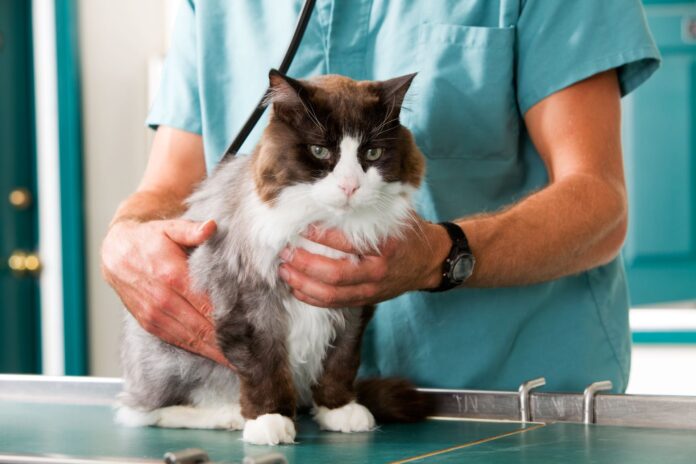Last Updated on August 10, 2023 by Fumipets
Exploring “Blood in Cat Stool” – A Comprehensive Overview
Introduction: Understanding Hematochezia
The article “Blood in Cat Stool: What Does It Mean?” addresses the concerning issue of blood in a cat’s stool, known as hematochezia. With a compassionate and informative tone, the article aims to provide readers with a deeper understanding of this symptom and its potential implications.
Identifying Hematochezia: Variations and Appearance
The article begins by acknowledging the distress that discovering blood in a cat’s stool can cause. It highlights that hematochezia can manifest in different forms, such as fresh blood, dark tarry stools, or streaks of blood.
The author emphasizes the importance of closely observing the appearance of the blood, as it can offer insights into potential causes.
Possible Causes of Hematochezia
Delving into the heart of the matter, the article explores a range of potential causes behind hematochezia in cats. It distinguishes between less severe factors, like dietary changes or stress, and more serious underlying issues, such as gastrointestinal disorders, infections, parasites, or even cancers.
The article stresses the need to avoid assumptions and encourages relying on veterinary expertise for accurate diagnosis.
Observing Behavior and Symptoms
To empower readers with knowledge, the article underscores the significance of observing the cat’s overall behavior, appetite, and any accompanying symptoms.
These observations can provide valuable information for veterinarians to determine the root cause of hematochezia. The article suggests that open communication with the vet and sharing relevant details can facilitate the diagnostic process.
Seeking Veterinary Attention: A Crucial Step
With a strong commitment to responsible pet care, the article emphasizes the critical nature of seeking prompt veterinary attention if blood in the stool is observed.
It warns against attempting to self-diagnose or self-treat and underscores the importance of a veterinarian’s expertise in ensuring the cat’s well-being.
What Does Blood Look Like in a Cat’s Stool?
Co-founding the Independent Veterinary Practitioners Association is Bonnie Bragdon, DVM, MS. According to her, there are two main forms of blood seen in cat poop:
Digested blood, which usually makes the entire elimination black – Fresh or bright red blood that may appear in your cat’s diarrhea, stool, or anus, According to the National Kitten Coalition, kittens often have additional problems, particularly in the first several months of life, which might result in a wide range of poo hues.
This diagram outlines potential reasons and the need for veterinarian treatment. Now, if you’re cleaning the litter box and see a few stray fresh blood drops, this typically means your cat has urinated blood.
It might be a sign of a variety of feline urinary health issues, including urolithiasis, urinary infection, urinary tract blockage, and feline idiopathic cystitis, according to the American Veterinary Medical Association. According to Bragdon, these situations call for rapid veterinarian attention.
Reasons Your Cat Has Blood in Their Stool
It depends on what the potential underlying issue is. According to Bragdon, a tiny quantity of blood seen just once is not likely to be an indication of a fatal illness. Whew! However, pay heed.
The most common causes of blood in cat feces are trauma related to constipation or bleeding from colitis (inflammation of the colon or large intestine).
There are several other causes as well, explains Bragdon, such as a foreign substance, cancer, inflammatory bowel disease, and infections. Even intestinal parasites like worms, which often don’t cause signs like blood in cat poop, sometimes do.
This is why keeping track of any blood in your cat’s stool as well as any other symptoms it exhibits may help your veterinarian diagnose the problem.
For instance, according to Bragdon, blood volume should be considered if a patient has a black, tarry stool, which is often a symptom of an upper gastrointestinal condition. “If feces are black, it could indicate bleeding in the stomach and small intestine,” she advises.
Here are some of Bragdon’s other justifications for the presence of blood in cat feces:
Fresh, crimson blood suggests rectum or large intestine issues.
Hard stools with bright red or fresh blood may indicate constipation, which may be the main issue, or they may be a secondary indication of gastrointestinal blockage or stricture.
Stools that are soft or watery and include fresh blood might indicate significant intestinal inflammation.
Furthermore, it’s simple to get alarmed if you discover blood and mucous in cat feces. Being an intestinal lubricant, a little amount of mucus in the poop is typical. However, if there is more than normal paired with blood, the kitten must see the clinic quickly.

What to Do if There’s Blood In Your Cat’s Poop
Start by documenting your cat’s behavior using photos. Even if your kitty friend seems to be in good health, Bragdon advises keeping a record of her symptoms over a few days and keeping an eye out for any indications of decline so your veterinarian can have a better idea of how she is doing overall.
The following signs and symptoms must be treated right once, generally within 24 to 72 hours:
Lethargy
Straining to eliminate
Vomiting
Stool with an unusual odor
Not eating or drinking
Copious amounts of blood, such as needing more than one wipe to clean
Diarrhea that doesn’t go away, or seems to clear up after three days but then returns
Hard stool for more than two days
No stool elimination at all for two days
Why Is My Cat Acting Normal if There’s Blood in Their Stool?
Home treatments for blood in cat poop are uncommon, but it’s likely that the blood is an indication that her digestive tract is somewhat irritated, in which case a brief change in her food could help.
Feed your cat moist food and water if the feces are hard and tough to compress between two paper towels, advises Bragdon. “Feed plenty of water and think about eating a bland diet if the stool is watery or soft.”
Conclusion: Guiding Cat Owners Responsibly
In conclusion, “Blood in Cat Stool: What Does It Mean?” serves as an informative and empathetic resource for cat owners facing the concerning issue of hematochezia.
It offers guidance, reassurance, and a reminder of the significance of timely veterinary care in maintaining the health and happiness of feline companions. The article stands as a valuable tool for informed decision-making and responsible pet ownership.
To rule out more severe illnesses, cats who are acting normally but sometimes or in little amounts have blood should still get a vet examination within a week or two.
Frequently Asked Questions
1. What does it mean if I find blood in my cat’s stool?
Discovering blood in your cat’s stool, known as hematochezia, can be concerning. It may indicate various underlying issues, ranging from minor to more serious health conditions. It’s crucial to seek veterinary guidance to determine the cause and appropriate course of action.
2. What are the different forms of blood in cat stool?
Blood in cat stool can appear in different forms, such as fresh blood, dark tarry stools, or streaks of blood. These variations in appearance can offer valuable insights into potential causes, aiding veterinarians in diagnosing the underlying problem.
3. What are some common causes of blood in cat stool?
There are several potential causes of blood in cat stool, including dietary changes, stress, gastrointestinal disorders, infections, parasites, and even certain cancers. It’s important not to jump to conclusions and to consult a veterinarian for accurate diagnosis and treatment.
4. What should I observe in my cat’s behavior when I notice blood in their stool?
When blood is present in your cat’s stool, it’s essential to observe their overall behavior, appetite, and any accompanying symptoms. These observations can provide valuable information for veterinarians to determine the underlying cause and tailor a suitable treatment plan.
5. Why is it crucial to seek veterinary attention promptly?
Seeking prompt veterinary attention when blood is present in your cat’s stool is crucial for several reasons. It ensures early diagnosis and treatment of any underlying health issues, prevents potential complications and promotes your cat’s overall well-being. A veterinarian’s expertise is essential for accurate assessment and guidance.
These FAQs offer insights into the comprehensive overview of “Exploring ‘Blood in Cat Stool’ – A Comprehensive Overview,” providing valuable information to cat owners who may encounter this concerning symptom. Remember, when faced with any health concerns, it’s always best to consult a veterinarian for professional advice and care.
https://www.youtube.com/watch?v=LbKD0IrkrHs


















